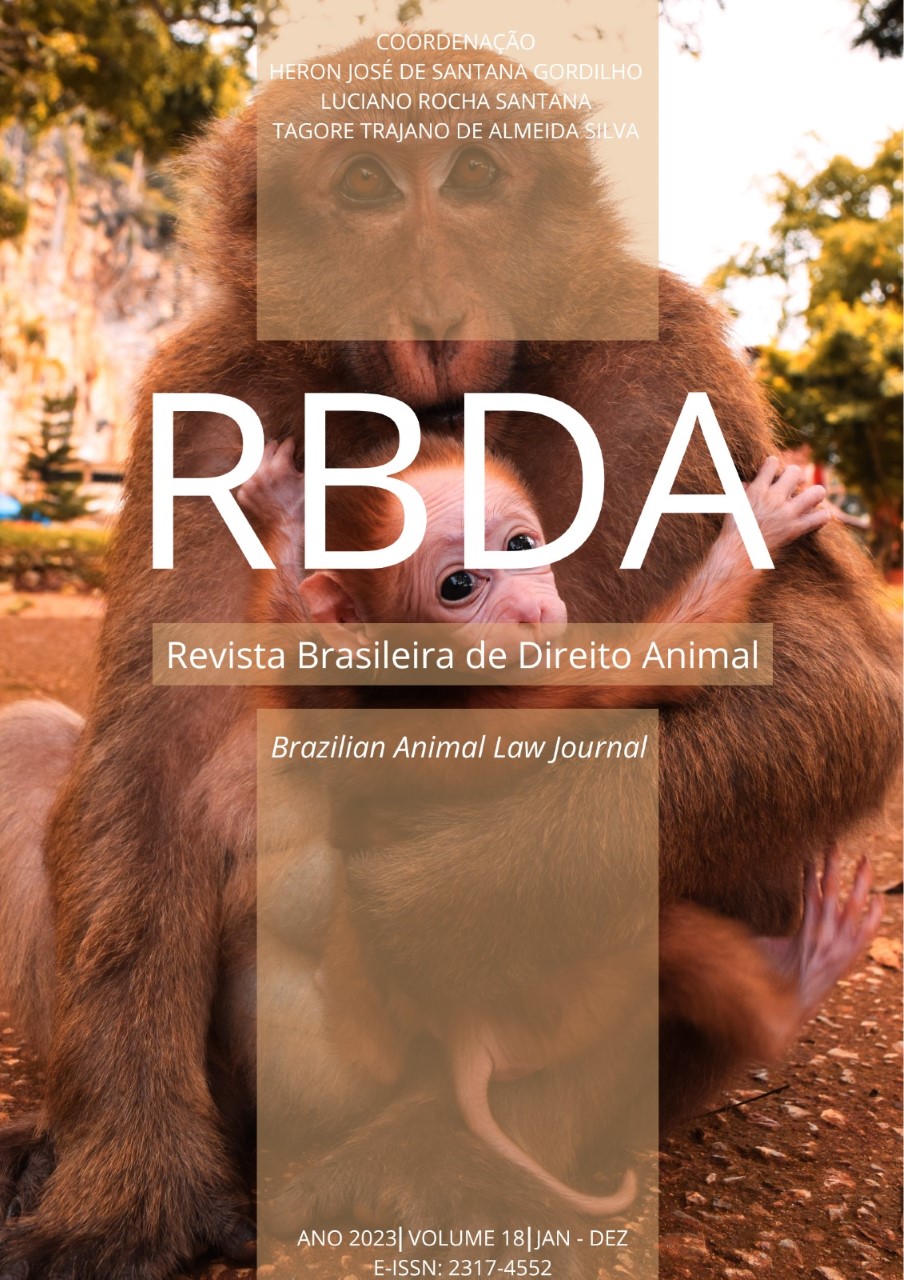WRITS OF HABEAS CORPUS FOR NONHUMAN PRIMATES IN THE UNITED STATES AND THE NONHUMAN RIGHTS PROJECT
LEGAL PROCESSES AND ARGUMENTS USED TO SECURE NONHUMAN ANIMAL RIGHTS
DOI:
https://doi.org/10.9771/rbda.v18i0.55647Keywords:
Green Criminology. Animal rights. Writs of habeas for animals. Nonhuman Animal Rights Project. Steven WiseAbstract
Questions concerning (nonhuman) animal rights have been increasingly addressed within the criminological literature due to growing interest in green criminology. Often within criminology, animal rights issues have been primarily addressed from philosophical standpoints, which omit how animal rights are addressed in more concrete terms through the legal system. This philosophical orientation toward animal rights, while important, has led to a neglect of the ways in which animal rights might be promoted through legal means. This article addresses that latter point by exploring the use of writs of habeas corpus for animals promoted by Steven Wise and the Nonhuman Rights Project (NhRP) in the US. Much of the NhRP’s efforts have been devoted to nonhuman primates, and consistent with that approach, this assessment focuses attention on legal efforts to protect nonhuman primates’ rights. In addition to NhRP efforts, other possibilities for using the law to obtain rights for animals in the US are examined. While this article focuses on circumstances in the US, several nations employ such writs or similar legal mechanisms
Downloads
References
Beers DL (2006) For the prevention of cruelty: The history and legacy of animal rights activism in the United States. Athens: Ohio University Press.
Beirne P (1995) The use and abuse of animals in criminology: A brief history and current review. Social Justice 22(1): 5–31.
Beirne P (1999) For a nonspeciesist criminology: Animal abuse as an object of study. Criminology 37(1): 117–148. https://doi.org/10.1111/j.1745-9125.1999.tb00481.x
Beirne P (2002) Criminology and animal studies: A sociological view. Society & Animals 10(4): 381–386. https://doi.org/10.1163/156853002320936845
Beirne P (2009a) Against cruelty? Understanding the act against plowing by the Tayle. In Beirne P (ed.) Confronting animal abuse: Law, criminology, and human–animal relationships: 21–68. Lanham: Rowman & Littlefield.
Beirne P (2009b) Confronting animal abuse: Law, criminology, and human–animal relationships. Lanham: Rowman &Littlefield.
Beirne P (2018) Murdering animals: Writings on theriocide, homicide and nonspeciesist criminology. New York: Springer.
Beirne P (2021) Wildlife trade and COVID-19: Towards a criminology of anthropogenic pathogen spillover. The British Journal of Criminology 61(3): 607–626. https://doi.org/10.1093/bjc/azaa084
Bendor AL and Dancig-Rosenberg H (2018) Animals rights in the shadow of the Constitution. Animal Law 24(1): 99–136.
Bilchitz D (2009) Moving beyond arbitrariness: The legal personhood and dignity of non-human animals. South African Journal on Human Rights 25(1): 38–72. https://doi.org/10.1080/19962126.2009.11865192
Brisman A and South N (2019) Green criminology and environmental crimes and harms. Sociology Compass 13(1): e12650. https://doi.org/10.1111/soc4.12650
Cazaux G (1998) Legitimating the entry of ‘the animals issue’ into (critical) criminology. Humanity & Society 22(4): 365–385. https://doi.org/10.1177/016059769802200403
Davis JM (2015) The history of animal protection in the United States. The American Historian 3(1). https://www.oah.org/tah/issues/2015/november/the-history-of-animal-protection-in-the-united-states/
Doss AM (2018) The profit and loss report on animal rights: How profit maximization has driven the stagnation of the legal identification of animals as property. University of Massachusetts Law Review 13(1): 140–176.
Favre DS (2005) Judicial recognition of the interests of animals: A new tort. Michigan State Law Review 2005(92): 333–367.
Flynn M and Hall M (2017) The case for a victimology of nonhuman animal harms. Contemporary Justice Review 20(3): 299–318. https://doi.org/10.1080/10282580.2017.1348898
Francione G. (2008) Animals as persons: Essays on the abolition of animal exploitation. New York: Columbia University Press.
Gacek J (2018) Species justice for police eagles: Analyzing the Dutch ‘flying squad’ and animal–human relations. Contemporary Justice Review 21(1): 2–15. https://doi.org/10.1080/10282580.2017.1413361
Gacek J and Jochelson R (2020) Animals as something more than mere property: Interweaving green criminology and law. Social Sciences 9(7): 122. https://doi.org/10.3390/socsci9070122
Gallup GG (1979) Self-awareness in primates: The sense of identity distinguishes man from most but perhaps not all other forms of life. American Scientist 67(4): 417–421.
Goodall J and Wise SM (1997) Are chimpanzees entitled to fundamental legal rights? Animal Law Review 3: 61–73. Goyes DR and Sollund R (2018) Animal abuse, biotechnology and species justice. Theoretical Criminology 22(3): 363–383.
https://doi.org/10.1177/1362480618787179
Lane BC (2011) Ravished by beauty: The surprising legacy of reformed spirituality. New York: Oxford University Press.
Lynch MJ and Genco LJ (2021) Cruelty against animals’ welfare (CAAW) violations: A study of Animal Welfare Act and Horse Welfare Act enforcement actions in the US, 2010–2014. Sociological Spectrum 41(3): 255–272.
https://doi.org/10.1080/02732173.2021.1893239
Lynch MJ, Stretesky PB and Long MA (2020) The treadmill of production and the treadmill of law: Propositions for analyzing law, ecological disorganization and crime. Capitalism, Nature, Socialism 31(1): 107–122. https://doi.org/10.1080/10455752.2018.1545241
Maddux EA (2012) Time to stand: Exploring the past, present, and future of nonhuman animal standing. Wake Forest Law Review 47(5): 1243–1267.
Nonhuman Rights Project (2023a). https://www.nonhumanrights.org/
Nonhuman Rights Project (2023b) Client, Kiko (Chimpanzee). https://www.nonhumanrights.org/client-kiko
Nonhuman Rights Project (2023c) Client, Tommy (Chimpanzee). https://www.nonhumanrights.org/client-tommy/
Nonhuman Rights Project. (20023d). Clients, Hercules and Leo (Chimpanzees). https://www.nonhumanrights.org/herculesleo/#:~:
text=Hercules%20and%20Leo%20are%20two,University's%20Department%20of%20Anatomical%20Sciences.
Nonhuman Rights (2018) Nonhuman Rights Project statement on Naruto v. Slater. Nonhuman Rights Blog, 24 April.
https://www.nonhumanrights.org/blog/nhrp-statement-monkey-selfie-case/
Nurse A (2016a) Animal harm: Perspectives on why people harm and kill animals. London: Routledge.
Nurse A (2016b) Beyond the property debate: Animal welfare as a public good. Contemporary Justice Review 19(2): 174–187. https://doi.org/10.1080/10282580.2016.1169699
Peters A (2020) Towards international animal rights. In Peters A (ed.) Studies in global animal law: 109–119. Berlin: Springer Nature.
Posner R (1990) The problems of jurisprudence. Cambridge: Harvard University Press.
Quinlan OL (1894) Have animals rights? Central Law Journal 38: 160–166.
Rice T (2013) Letting the apes run the zoo: Using tort law to provide animals with a legal voice. Pepperdine Law Review 40(4): 1103–1142.
Schultz AH (1936) Characters common to higher primates and characters specific for man. The Quarterly Review of Biology 11(3): 259–283.
Silverstein H (2009) Unleashing rights: Law, meaning, and the animal rights movement. Ann Arbor: University of Michigan Press.
Smith J (2007) Primarily primates: AG folds on apes. The Austin Chronicle, 4 May.
http://www.austinchronicle.com/news/2007-05-04/471787/
Sollund R (2020) Wildlife management, species injustice and ecocide in the Anthropocene. Critical Criminology 28(3): 351–369. https://doi.org/10.1007/s10612-019-09469-1
State of New York Court of Appeals (2018) Motion No. 2018-268 in the matter of Nonhuman Rights Project, Inc v. Lavery.
http://www.nycourts.gov/ctapps/Decisions/2018/May18/M2018-268opn18-Decision.pdf
Stephens-Griffin N (2022) Biting back: A green-cultural criminology of animal liberation struggle as constructed through online communiques. Crime, Media, Culture. https://doi.org/10.1177/17416590221110118
Taylor N and Fitzgerald A (2018) Understanding animal (ab)use: Green criminological contributions, missed opportunities and a way forward. Theoretical Criminology 22(3): 402–425. https://doi.org/10.1177/1362480618787173
Torres B (2007) Making a killing: The political economy of animal rights. Oakland: AK Press.
Tschakert P, Schlosberg D, Celermajer D, Rickards L, Winter C, Thaler M, Stewart‐Harawira M and Verlie B (2021)
Multispecies justice: Climate‐just futures with, for and beyond humans. WIREs Climate Change 12(2): e699. https://doi.org/10.1002/wcc.699
Varki A and Gagneux P (2017) How different are humans and ‘great apes’? A matrix of comparative anthropogeny. In Tibayrenc M and Ayala FJ (eds) On human nature: 151–160. Cambridge: Academic Press.
Weiss A (2017) A human model for primate personality. Proceedings of the Royal Society B 284(1864): 20171129. https://doi.org/10.1098/rspb.2017.1129
Westerlaken M (2021) What is the opposite of speciesism? On relational care ethics and illustrating multi-species-isms. International Journal of Sociology and Social Policy 41(3/4): 522–540. https://doi.org/10.1108/ijssp-09-2019-0176
Wise SM (1996) The legal thinghood of nonhuman animals. Boston College Environmental Affairs Law Journal 23(3): 471–546.
Wise SM (1997) Hardly a revolution: The eligibility of nonhuman animals for dignity-rights in a liberal democracy. Vermont Law Review 22(4): 793–916.
Wise SM (2006) The entitlement of chimpanzees to the common law writs of habeas corpus and de homine replegiando. Golden Gate University Law Review 37(2): 219–280.
Wise SM (2010) Legal personhood and the nonhuman rights project. Animal Law 17(1): 1–12.
Downloads
Published
How to Cite
Issue
Section
License
Copyright (c) 2023 Brazilian Animal Law Journal

This work is licensed under a Creative Commons Attribution-NonCommercial 4.0 International License.
1. Autores mantém os direitos autorais e concedem à revista o direito de primeira publicação, com o trabalho simultaneamente licenciado sob a Licença Creative Commons Atribuição 4.0 Internacional que permite o compartilhamentodo trabalho com reconhecimento da autoria e publicação inicial nesta revista.
2. Autores têm autorização para assumir contratos adicionais separadamente, para distribuição não-exclusiva da versão do trabalho publicada nesta revista (ex.: publicar em repositório institucional ou como capítulo de livro), com reconhecimento de autoria e publicação inicial nesta revista.
3. Autores têm permissão e são estimulados a publicar e distribuir seu trabalho online (ex.: em repositórios institucionais ou na sua página pessoal) a qualquer ponto antes ou durante o processo editorial, já que isso pode gerar alterações produtivas, bem como aumentar o impacto e a citação do trabalho publicado.












